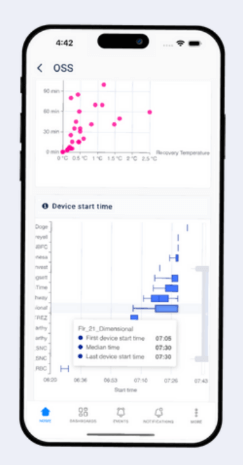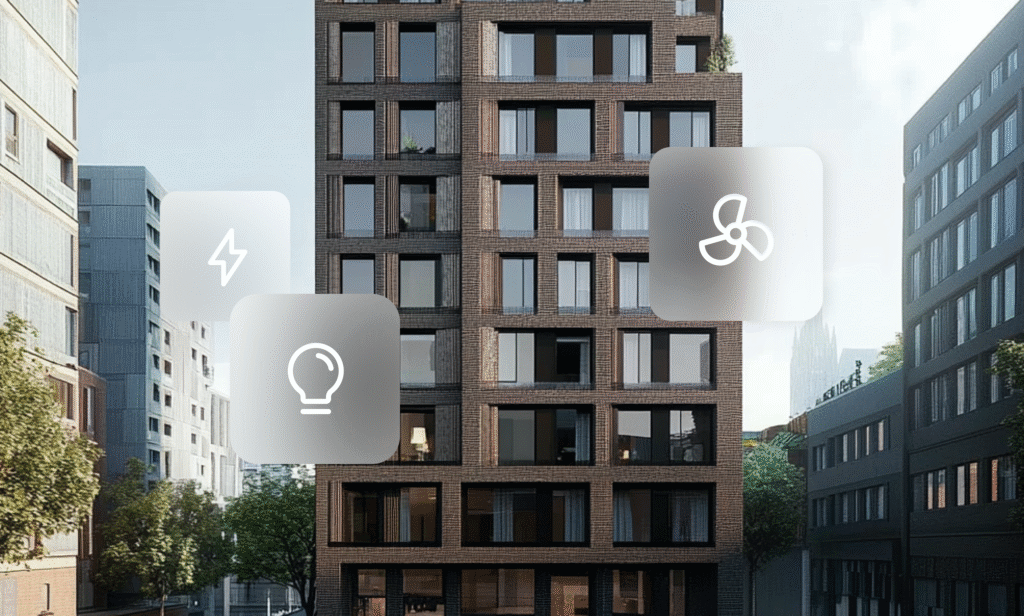
Building
Chrysler House
Office & Retail

Location
Detroit, MI, US

Solution
Equipment Performance Optimization
Energy Savings
By KODE Team
On this page
Sign up to our newsletter
Subscribe to receive the latest blog posts to your inbox every week.
By subscribing you agree to with our Privacy Policy.
Bedrock Detroit is the largest commercial real estate firm in downtown Detroit with over 100 buildings and close to 20 million square feet under management. The Chrysler House building was the first to implement KODE’s first machine learning solution – Optimized Start/Stop (OSS). The switch to KODE’s OSS resulted in clear energy savings, demonstrating the tangible benefits of integrating advanced technology with everyday building operations.
Introduction to Optimized Start/Stop
An Optimized Start-Stop function is utilized to save energy and equipment runtime around defined occupancy schedules. The Optimized Start will ensure that the occupied space is at or within range of the set point at the start of the occupied period with the minimum equipment runtime. Optimized Stop allows the preemptive shutdown of equipment prior to the end of the occupied period. KODE Labs has developed an OSS for Air Handling Unit (AHU) equipment which uses a machine learning model. This
model extracts information through the historical data collected from the zone control and AHU operation to predict the required time duration, under specific conditions, to achieve or maintain set point. These predictions are used and modified daily to adjust the occupancy schedule for the associated AHU.
Approach
The development of the OSS adhered to the CRISP-DM methodology, which includes six phases: understanding business needs, understanding the data, preparing the data, modeling, evaluating, and deployment.
Challenge
The issue at hand was the inefficient operation of AHUs, leading to energy waste when the set point was reached too early, or occupant discomfort when reached too late.

We have explored the data available to complete a proof of concept model using a 24 story building, with 23 AHUs and 320 VAV. This building had a previously existing OSS in place which had been manipulated or disabled and as such was disabled in August 2020 when our testing began. We were primarily concerned with three sensors:
- Zone Temperature,
- Zone Temperature Setpoint, and
- Discharge Air Command.
Our analysis of the legacy OSS algorithm and verification of the local building schedules identified excessive duration and waste energy periods prior to the occupied periods which showed significant room for improvement. Metrics used to make comparisons and estimations are:
- Average runtime of AHUs (h) – on average, how many hours a day do AHUs stay on,
- Total runtime of AHUs (h) – for how many hours in total have AHUs stayed on,
- Energy spent (kwh),
- Energy costs ($),
- Pre-occupancy duration/energy runtime (h).

Solution
Our goal was to accurately predict the time it would take for equipment to reach the set temperature, thereby reducing energy
waste and improving occupant comfort.
We used a supervised machine learning approach with a random forest regression model, considering factors like outdoor conditions and historical temperature
patterns.


Results
Testing our model at Chrysler House with 23 AHUs and 320 VAVs yielded impressive results. The data showed a substantial reduction in energy waste and operational costs. In August 2020, the first month
after implementing our OSS, we observed a 9.02% reduction in energy costs compared to the previous month.
We also noted a marked decrease in the average runtime of AHUs per day and overall energy use. Our analysis of the legacy OSS system revealed excessive runtimes before occupancy periods, indicating a significant opportunity for improvement.
Further findings
In our examination, we compared the time required to reach setpoint against the hours when energy was unnecessarily used. The results were striking: a 55.93% reduction in wasted energy runtime in August 2020 when compared to July 2020.

Our review of building performance under the KODE Labs Machine Learning Model for AHU scheduling
indicates substantial benefits. Not only does the model cut costs, but it also leads to more efficient
equipment use. The case study of Chrysler House with KODE’s OSS validates our approach as a
significant step forward in smart building management.




